Environment Biodiversity compared to last year UPSC
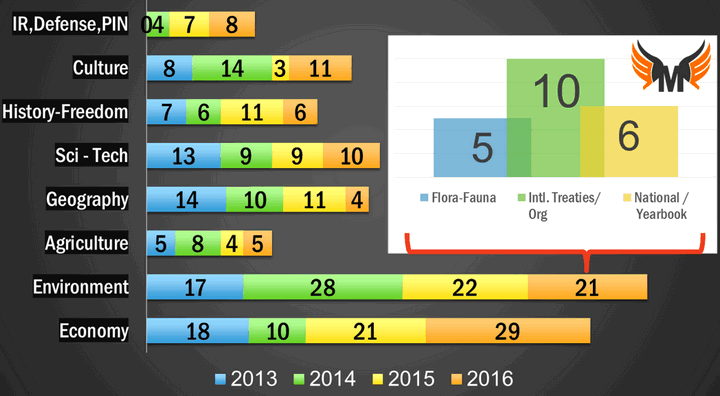
| 2015 | 2016 |
|---|---|
| Yearbook type: Genetic Engineering Appraisal Committee asked. It was given on Page 303 of IYB-2015. | Ganga Basin Authority asked – but it’s given in IYB-2014. |
International treaties / org: asked about
|
|
| — | Good number of questions from topics that were hot 2 Mains ago e.g. Ganga authority, Net Metering, Kasturi-Gadgil etc. |
| MCQs on Environmental R&D e.g. Biotoillets, IndARC, fuel cells. | None. |
Flora fauna
|
Flora fauna
|
For environment, As such the 2016’s paper is more- like 2015’s paper i.e. Majority of MCQs in easy to medium category. Unlike 2014’s paper where environment was a very tough cookie to crack.
Road ahead for Environment, biodiversity
- Since UPSC has combined the preliminary exams of both civil services and forest service, therefore, 1) significant portion of the paper will be occupied by this topic 2) some of the questions will be rather tough/technical for ordinary aspirant.
- But all in all, not too much outside the conventions sources i.e. NCERT, NIOS, ShankarIAS and Mrunal’s lecture videos on the international summits. Preparation should be centered around this circle.
Conclusion: 2016 Prelim GS-Paper- overall current and toughness
With this article, general studies Answerkey is over. So how does the overall paper look like?

| 38 |
|
|---|---|
| 62 |
|
| Toughness | Yes this is completely subjective classification: Out of total 100 GS questions
|
| REFERENCE |
|
Environment: International Treaties / Org: 10 MCQs
5. Consider the following pairs :
| Terms sometimes seen in the news | Their origin |
|---|---|
| 1. Annex—I Countries | Cartagena Protocol |
| 2. Certified Emissions Reductions | Nagoya Protocol |
| 3. Clean Development Mechanism | Kyoto Protocol |
Which of the pairs given above is/are correctly matched?
(a) 1 and 2 only
(b) 2 and 3 only
(c) 3 only
(d) 1, 2 and 3
<atarget=”_blank” title=”Proof screenshot that UPSC prelim question could be solved from Mrunal.org – because bogus marketing propoganda is as important as teaching” href=”http://flic.kr/p/LbTfmy”>
Mrunal Lecture L8/P6: Climate finance: All three terms are associated with Kyoto Protocol. Therefore, answer “C” 3 only.
27. With reference to an initiative called ‘The Economics of Ecosystems and Biodiversity (TEEB)’, which of the following statements is/are correct?
1. It is an initiative hosted by UNEP, IMF and World Economic Forum.
2. It is a global initiative that focuses on drawing attention to the economic benefits of biodiversity.
3. It presents an approach that can help decision-makers recognize, demonstrate and capture the value of ecosystems and biodiversity.
Select the correct answer using the code given below.
(a) 1 and 2 only
(b) 3 only
(c) 2 and 3 only
(d) 1, 2 and 3
TEEB was launched by Germany and EU (2007) so, first statement is wrong. 2nd and 3rd statements are correct. Ref: ShankarIAS Environment book Chapter 23, Page 260
29. Which of the following statements is/are correct?
Proper design and effective implementation of UN-REDD+ Programme can significantly contribute to
1. protection of biodiversity
2. resilience of forest ecosystems
3. poverty reduction
Select the correct answer using the code given below.
(a) 1 and 2 only
(b) 3 only
(c) 2 and 3 only
(d) 1, 2 and 3
Mrunal’s article on Warsaw summit: Under REDD+ Developing country will have to prove the ‘result’ they have fought deforestation without harming local communities or biological diversity. Only then, they’ll get the Money. So, 1 and 2 are correct. Answer could be “A”
What about 3rd statement?
| 3rd is right |
|
| 3rd is wrong |
|
Final answer: UPSC’s official answerkey.
UPDATE: Official UPSC Answer – D: all three benefits.
30. What is ‘Greenhouse Gas Protocol’?
(a) It is an international accounting tool for government and business leaders to understand, quantify and manage greenhouse gas emissions
(b) It is an initiative of the United Nations to offer financial incentives to developing countries to reduce greenhouse gas emissions and to adopt eco-friendly technologies
(c) It is an inter-governmental agreement ratified by all the member countries of the United Nations to reduce greenhouse gas emissions to specified levels by the year 2022
(d) It is one of the multilateral REDD+ initiatives hosted by the World Bank
A is correct according to their “ABOUT US” page
32. With reference to ‘Agenda 21’, sometimes seen in the news, consider the following statements :
1. It is a global action plan for sustainable development
2. It originated in the World Summit on Sustainable Development held in Johannesburg in 2002.
Which of the statements given above is/are correct?
(a) 1 only
(b) 2 only
(c) Both 1 and 2
(d) Neither 1 nor 2
<atarget=”_blank” title=”Proof screenshot that UPSC prelim question could be solved from Mrunal.org – because bogus marketing propoganda is as important as teaching” href=”http://flic.kr/p/Kpvo42″>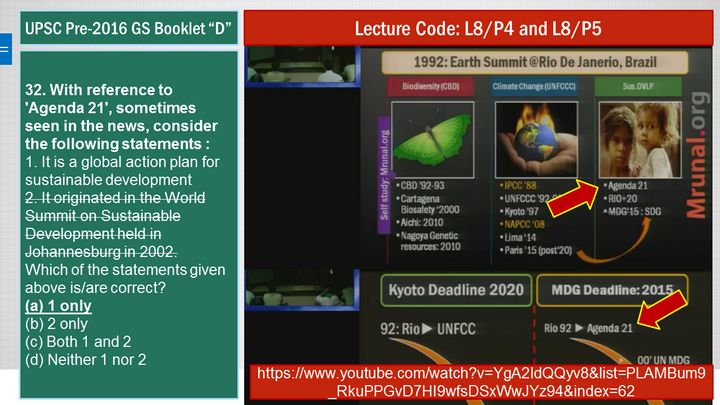
Mrunal’s Lecture L8/P4 and P5: Agenda-21 associated with SDG and originated from Rio earth summit in 1992.
Another source, Mrunal’s article on Rio+20: Agenda 21 is a non-binding, voluntarily implemented action plan of the United Nations with regards to sustainable development. It is a product of the Earth Summit held in Rio de Janeiro, Brazil, in 1992.
Therefore, only first statement right.
56. Consider the following statements:
(1) The International Solar Alliance was launched at the United Nations Climate Change Conference in 2015.
(2) The Alliance includes all the member countries of the United Nations.
Which of the statements given above is/are correct?
(a) 1 only
(b) 2 only
(c) Both 1 and 2
(d) Neither 1 nor 2
<atarget=”_blank” title=”Proof screenshot that UPSC prelim question could be solved from Mrunal.org – because bogus marketing propoganda is as important as teaching” href=”http://flic.kr/p/LbTfeu”>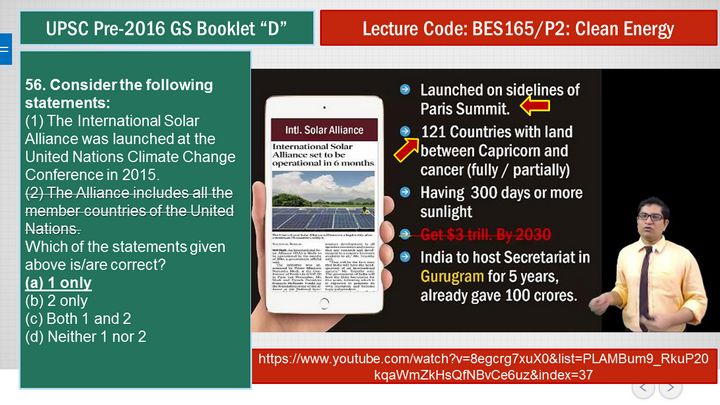
Mrunal’s lecture BES165/P2: Clean Energy. While ISA was launched on Sidelines of Paris Summit, therefore first statement right but it includes only the 121 countries between Capricorn and Cancer receiving sunlight for 300 days or more. Hence 2nd statement wrong.
72. With reference to the Agreement at the UNFCCC Meeting in Paris in 2015, which of the following statements is/are correct?
1. The Agreement was signed by all the member countries of the UN and it will go into effect in 2017.
2. The Agreement aims to limit the greenhouse gas emissions so that the rise in average global temperature by the end of this century does not exceed 2 °C or even 1.5 °C above pre-industrial levels.
3. Developed countries acknowledged their historical responsibility in global warming and committed to donate $ 1000 billion a year from 2020 to help developing countries to cope with climate change.
Select the correct answer using the code given below.
(a) 1 and 3 only
(b) 2 only
(c) 2 and 3 only
(d) 1, 2 and 3
<atarget=”_blank” title=”Proof screenshot that UPSC prelim question could be solved from Mrunal.org – because bogus marketing propoganda is as important as teaching” href=”http://flic.kr/p/KpvnWt”>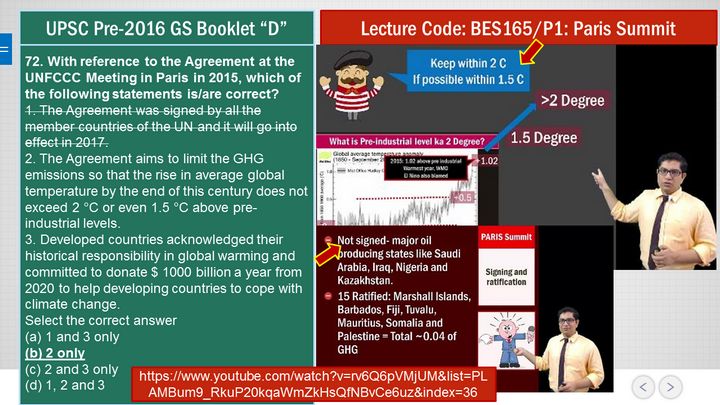
Mrunal’s Lecture BES165/P1 Paris Summit: Paris Summit- not all nations have signed the agreement and there is no deadline to ratify it. hence, statement 1 is wrong. This eliminates A and D. And developed countries committed to give $100 billion by 2020. and for future, there is no mention of giving $1,000 billion dollars. Therefore third statement wrong. We are left with Answer (B) only.
73. Consider the following statements:
1. The Sustainable Development Goals were first proposed in 1972 by a global think tank called the ‘Club of Rome’.
2. The Sustainable Development Goals have to be achieved by 2030.
Which of the statements given above is/are correct?
(a) 1 only
(b) 2 only
(c) Both 1 and 2
(d) Neither 1 nor 2
Club of Rome talked about “limits to growth”. But I’m unable to find concrete source that specifically says they were the first to propose. 2nd Statement is right: Mrunal’s Lecture BES166/P4.
81. The term ‘Intended Nationally Determined Contributions’ is sometimes seen in the news in the context of
(a) pledges made by the European countries to rehabilitate refugees from the war-affected Middle East
(b) plan of action outlined by the countries of the world to combat climate change
(c) capital contributed by the member countries in the establishment of Asian Infrastructure Investment Bank
(d) plan of action outlined by the countries of the world regarding Sustainable Development Goals
<atarget=”_blank” title=”Proof screenshot that UPSC prelim question could be solved from Mrunal.org – because bogus marketing propoganda is as important as teaching” href=”http://flic.kr/p/KUQxhY”>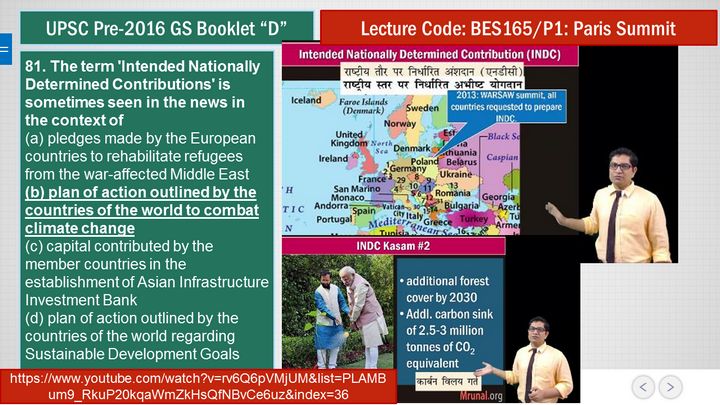
Mrunal’s Lecture BES165/P1 INDC are associated with UNFCCC-Climate change.
88. What is/are the importance/importance of the ‘United Nations Convention to Combat Desertification’?
1. It aims to promote effective action through innovative national programs and supportive inter-national partnerships.
2. It has a special/particular focus on South Asia and North Africa regions, and its Secretariat facilitates the allocation of major portion of financial resources to these regions.
3. It is committed to bottom-up approach, encouraging the participation of local people in combating the desertification.
Select the correct answer using the code given below.
(a) 1 only
(b) 2 and 3 only
(c) 1 and 3 only
(d) 1, 2 and 3
2nd statement wrong because The implementation of the UNCCD is geared around five regional implementation annexes: Annex 1 for Africa, Annex 2 for Asia, Annex 3 for Latin America and the Caribbean, Annex 4 for Northern Mediterranean and Annex 5 for Central and Eastern Europe. Ref: Official page. Third statement right, According to this official page of this convention
Therefore, answer C. Tough question.
Environment: National Schemes/Yearbook type: 6 MCQs
8. Which of the following best describes/ describe the aim of ‘Green India Mission’ of the Government of India?
1. Incorporating environment al benefits and costs into the Union and State Budgets thereby implementing the `green accounting’
2. Launching the second green revolution to enhance agricultural output so as to ensure food security to one and all in the future
3. Restoring and enhancing forest cover and responding to climate change by a combination of adaptation and mitigation measures
Select the correct answer using the code given below.
(a) 1 only
(b) 2 and 3 only
(c) 3 only
(d) 1, 2 and 3
<atarget=”_blank” title=”Proof screenshot that UPSC prelim question could be solved from Mrunal.org – because bogus marketing propoganda is as important as teaching” href=”http://flic.kr/p/KUQxdE”>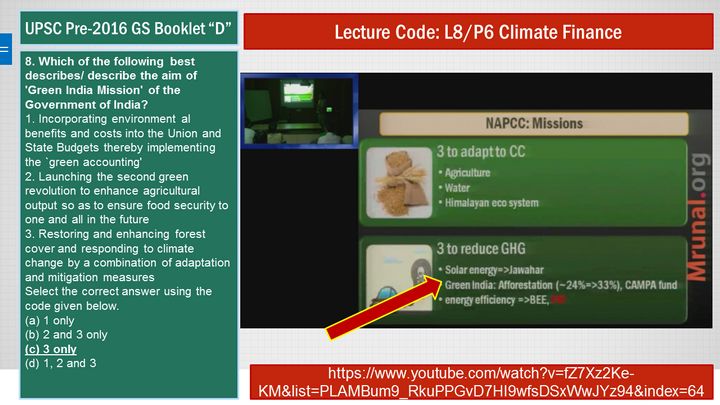
Mrunal Lecture L8/P6: Green India = afforestation. Hence only 3 is right.
Another source: India Yearbook 2016 page 338: Environment ministry has launched National Mission for a Green India through a consultative process involving relevant stakeholders, aimed at both increasing the forest and tree cover by 5 million ha, as well as increasing the quality of the existing forest cover in another 5 million ha.
11. ‘Net metering’ is sometimes seen in the news in the context of promoting the
(a) production and use of solar energy by the households/consumers
(b) use of piped natural gas in the kitchens of households
(c) installation of CNG kits in motor-cars
(d) installation of water meters in urban households
Mrunal’s revision note for Mains-2014: Under Net-metering system, Customer installs a solar or windpower plant on his premise, gets it grid-connected with the electricity distribution company (DISCOM)
Hence I keep saying, lot of MCQs from topics that are ‘two mains old’.
53. On which of the following can you find the Bureau of Energy Efficiency Star Label?
1. Ceiling fans
2. Electric geysers
3. Tubular fluorescent lamps
Select the correct answer using the code given below.
(a) 1 and 2 only
(b) 3 only
(c) 2 and 3 only
(d) 1, 2 and 3
According to centre for science and environment (CSE), both 1 and 3 are correct. There is only option “D” whether such combination is possible. January 2016 amendment confirms that electric water heater / geysers also covered in this scheme- Ref: original Notification
61. In the cities of our country, which among the following atmospheric gases are normally considered in calculating the value of Air Quality Index?
1. Carbon dioxide
2. Carbon monoxide
3. Nitrogen dioxide
4. Sulfur dioxide
5. Methane
Select the correct answer using the code given below.
(a) 1, 2 and 3 only
(b) 2, 3 and 4 only
(c) 1, 4 and 5 only
(d) 1, 2, 3, 4 and 5
Mrunal summary note on Air Quality index: Among them, NO2, SO2 and CO are given. Hence by elimination, option “B” is correct. Ye bhi 2 mains old topic.
98. Which of the following are the key features of ‘National Ganga River Basin Authority (NGRBA)’?
1. River basin is the unit of planning and management.
2. It spearheads the river conservation efforts at the national level.
3. One of the Chief Ministers of the States through which the Ganga flows becomes the Chairman of NGRBA on rotation basis.
Select the correct answer using the code given Below.
(a) 1 and 2 only
(b) 2 and 3 only
(c) 1 and 3 only
(d) 1, 2 and 3
In 2014, UPSC asked similar question, where one of the statement was- “PM is chairman of NGRBA”.
Ref: Mrunal’s answerkey. That statement was right as per India Yearbook 2014. Therefore, here statement 3 is wrong, CM can’t by the chairman of NGRBA. By elimination, we reach answer (A).
Alternative Reference: ShankarIAS Environment book Ch.5, page 56 – third paragraph.
Matlab- “2 PRELIMS old Topic”!
43. ‘Gadgil Committee Report’ and ‘Kasturirangan Committee Report’, sometimes seen in the news, are related to
(a) constitutional reforms
(b) Ganga Action Plan
(c) linking of rivers
(d) protection of Western Ghats
They’re associated with Western Ghat conservation plan. Mrunal’s article Four years ago. Ye toh hadd hi ho gyi.
Environment: Flora-Fauna: 5 MCQs
19. What is/are unique about ‘Kharai camel’, a breed found in India?
1. It is capable of swimming up to three kilometres in seawater.
2. It survives by grazing on mangroves.
3. It lives in the wild and cannot be domesticated.
Select the correct answer using the code given below.
(a) 1 and 2 only
(b) 3 only
(c) 1 and 3 only
(d) 1, 2 and 3
In a way tough question, in a way easy question. If we go by gut-feeling that all camels can be domesticated, then easily by elimination we are left with answer A). Anyways, let’s crosscheck:
According to Downtoearth website
- They can swim up to three kilometers into the sea in search of mangroves – So, 1 and 2 are correct.
- Same page mentions: Most families in Jatt and Rabari communities of Kachchh, are traditional rearers of Kharai camels. So, third statement is wrong. By elimination we are left with A)
In 2015, April they were to given endangered species status hence in News.
20. Recently, our scientists have discovered a new and distinct species of banana plant which attains a height of about 11 metres and has orange-coloured fruit pulp. In which part of India has it been discovered?
(a) Andaman Islands
(b) Anaimalai Forests
(c) Maikala Hills
(d) Tropical rain forests of northeast
2015, October theHindu: Scientists at the Botanical Survey of India (BSI) have discovered a new species of banana from a remote tropical rain forest on the Little Andaman islands. The new species is about 11 metres high, whereas as the usual banana species is about three to four metres high. The fruit pulp is orange in colour, distinctive from the white and yellow colour of regular bananas.
28. With reference to ‘Red Sanders’, sometimes seen in the news, consider the following statements:
1. It is a tree species found in a part of South India.
2. It is one of the most important trees in the tropical rain forest areas of South India.
Which of the statements given above is/are correct?
(a) 1 only
(b) 2 only
(c) Both 1 and 2
(d) Neither 1 nor 2
- It was in national media during April 2015, when Andhra Pradesh police killed 20 Red Sander smugglers in an encounter. So first statement is right.
- Red Sanders is associated with Tropical dry deciduous forest. Says google book and . MoEF Hence 2nd statement wrong.
65. Recently, for the first time in our country, which of the following States has declared a particular butterfly as ‘State Butterfly’?
(a) Arunachal Pradesh
(b) Himachal Pradesh
(c) Karnataka
(d) Maharashtra
June 2015 theHindu: Maharashtra government has declared the Blue Mormon (Papilio polymnestor) as the State butterfly.
97. In which of the following regions of India are you most likely to come across the `Great Indian Hornbill’ in its natural habitat?
(a) Sand deserts of northwest India
(b) Higher Himalayas of Jammu and Kashmir
(c) Salt marshes of western Gujarat
(d) Western Ghats
It seems UPSC’s prem for Great Indian Bustard and Vultures died by Diclofenac, is vanished and now its new love-interest is Great Indian Hornbill. Frontline says the great Indian hornbill is found in the dense emerald patches of the Western Ghats, the bird is also known as the bird of the heavy rainforest.
Ref: Frontline and Google Book
As such every once in a while, theHindu would publish some travelogue / safari type article in its metro editions, but there are dozens of such birds, animals, reptiles. Difficult to memorize and recall which is found where.
Geography and Agriculture compared to last year
| 2015 | 2016 |
|---|---|
| 86. Consider the following rivers: 1. Vamsadhara 2. Indravati 3. Pranahita 4. Pennar Which of the above are tributaries of Godavari? (a) 1, 2 and 3 (b) 2, 3 and 4 (c) 1, 2 and4 (d) 2 and 3 only |
Last year Godavari, now this year Brahmaputra tributaries asked.3. Which of the following is/are tributary tributaries of Brahmaputra? 1. Dibang 2. Kameng 3. Lohit Select the correct answer using the code given below. (a) 1 only (b) 2 and 3 only (c) 1 and 3 only (d) 1, 2 and 3 |
| World geography two MCQs | Nothing from world geography, but they did ask good amount of IR. |
| Geography had lot of variety- some ‘pairing’ question, some map based questions, some physical geography “factors-affecting” type question and so on…. | Just four MCQs. 1 on Energy and 3 on river/ports linking. |
Agriculture:
|
Agriculture:
|
Road ahead for Geography and Agriculture
- Although not much geography asked in prelims this time, but since it comes again in Mains-exam General Studies paper-1 so it has to be prepared in a diligent manner- starting with the NCERTs. (Though 2016 was worst case scenario- still one MCQ has come from Class-11 NCERT- like last few years). Class-11 NCERT has to be prepared by heart- whether appearing in CSE or CAPF or CDS.
- Every subject reaches its peak and then falls down. Geography and Polity have touched almost the bottom with hardly 4-6 MCQs from each. So within 1 or 2 prelims again their rise should come.
Geography: 4 MCQs; 1 From NCERT
3. Which of the following is/are tributary tributaries of Brahmaputra?
1. Dibang
2. Kameng
3. Lohit
Select the correct answer using the code given below.
(a) 1 only
(b) 2 and 3 only
(c) 1 and 3 only
(d) 1, 2 and 3
NCERT Physical Geography Class11, Ch.3 Drainage system Page, 26
Brahmaputra’s main left bank tributaries, viz., Dibang or Sikang and Lohit…. the important right bank tributaries are the Subansiri, Kameng, Manas and Sankosh.
Therefore, all 3 correct. Although rather difficult to recall in examhall, given the factual nature of information.
49. In which of the following regions of India are shale gas resources found?
1. Cambay Basin
2. Cauvery Basin
3. Krishna-Godavari Basin
Select the correct answer using the code given below.
(a) 1 and 2 only
(b) 3 only
(c) 2 and 3 only
(d) 1, 2 and 3
<atarget=”_blank” title=”Proof screenshot that UPSC prelim question could be solved from Mrunal.org – because bogus marketing propoganda is as important as teaching” href=”http://flic.kr/p/Kpvo8R”>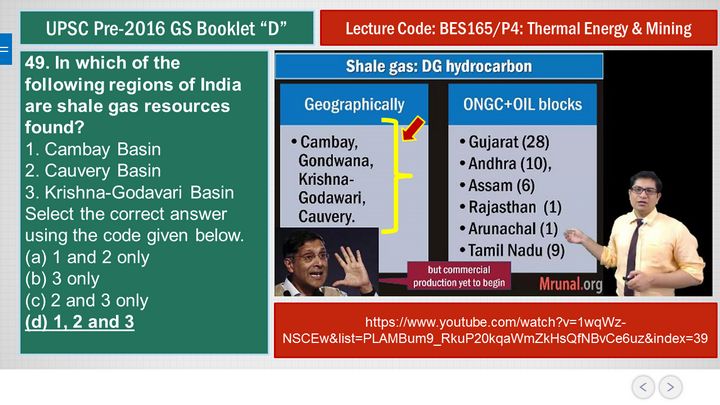
Mrunal’s Lecture BES165/P4: Thermal Energy: – all of them are correct.
This is verbatim given in Economic Survey 2013, page 196 [again two mains old report- because 2013 survey means it was published in Feb-2014].
A regular aspirant can’t be expected to have gone through such old information or memorize it. This is sheer luck / Khudaa mehrbaan that somehow I got this last minute idea to add that info. in present year’s video and slide.
60. Recently, linking of which of the following rivers was undertaken?
(a) Cauvery and Tungabhadra
(b) Godavari and Krishna
(c) Mahanadi and Sone
(d) Narmada and Tapti
<atarget=”_blank” title=”theHindu” href=”http://www.thehindu.com/news/national/andhra-pradesh/after-river-interlinking-focus-on-water-tanks/article8867726.ece”>July 2016 theHindu: Andhra Pradesh Government has succeeded in interlinking Krishna-Godavari rivers through the Pattiseema lift irrigation scheme and 10,000 cusecs of water from the Godavari was being presently drawn on a daily basis through the project to meet the requirements of the Krishna delta.
71. Recently, which of the following States has explored the possibility of constructing an artificial inland port to be connected to sea by a long navigational channel?
(a) Andhra Pradesh
(b) Chhattisgarh
(c) Karnataka
(d) Rajasthan
Rajasthan wants to develop artificial inland shipping port at Jalore, it’ll be connected to the Arabian Sea by developing a channel along the Kutch Creek. Difficult because factual question from a low profile news item from June-August 2015 from PIB and then again in November 2015 Economic Times
Agriculture: 5 MCQs
2. The FAO accords the status of ‘Globally Important Agricultural Heritage System (GIAHS)’ to traditional agricultural systems. What is the overall goal of this initiative?
1. To provide modern technology, training in modern farming methods and financial support to local communities of identified GIAHS so as to greatly enhance their agricultural productivity
2. To identify and safeguard eco-friendly traditional farm practices and their associated landscapers, agricultural biodiversity and knowledge systems of the local communities
3. To provide Geographical Indication status to all the varieties of agricultural produce in such identified GIAHS
Select the correct answer using the code given below.
(a) 1 and 3 only
(b) 2 only
(C) 2 and 3 only
(d) 1, 2 and 3
This stupid and obscure topic is 4 years old. Covered in Mrunal -“Misc. category” article
There is no provision to give GI to “ALL” variety. Hence by that logic, eliminate all options and we are left with answer B- only 2.
23. With reference to ‘Initiative for Nutritional Security through Intensive Millets Promotion’, which of the following statements is/are correct?
1. This initiative aims to demonstrate the improved production and post-harvest technologies, and to demonstrate value addition techniques, in an integrated manner, with cluster approach.
2. Poor, small, marginal and tribal farmers have larger stake in this scheme.
3. An important objective of the scheme is to encourage farmers of commercial crops to shift to millet cultivation by offering them free kits of critical inputs of nutrients and micro irrigation equipment.
Select the correct answer using the code given below.
(a) 1 only
(b) 2 and 3 only
(c) 1 and 2 only
(d) 1, 2 and 3
This is not given in India yearbook or Economy survey. (Atleast on the first glance I did not find it). Now who has time to prepare such low-profile schemes. Anyways, Agri website Notification
- First statement is right
- 2nd statement is right – by logic that millet cultivation is done by such poor, marginal, tribals only. And not be the tracktor walla rich farmers in Punjab and Haryana.
- As such policy aims to give free kits but “wanting to shift commercial crop farmers to millet” doesn’t fit logic (after all tractor walla is not the target audience). There is no such mention in the scheme, nor any talk about giving micro-irrigation equipment. Hence 3rd statement wrong.
58. Which of the following is/are the advantage /advantages of practising drip irrigation?
1. Reduction in weed
2. Reduction in soil salinity
3. Reduction in soil erosion
Select the correct answer using the code given below.
(a) 1 and 2 only
(b) 3 only
(c) 1 and 3 only
(d) None of the above is an advantage of practising drip irrigation
Drip irrigation wets less ground, hence less weed seeds germinate. Therefore, statement #1 is right Ref: Google Book
Statement #2 is wrong According to Austrialian government website
Irrigation salinity is the rise in saline groundwater and the buildup of salt in the soil surface in irrigated areas. What can I do to avoid it? They’ve suggsted avoiding over-irrigation of crops by using techniques such as drip irrigation. Hence eliminate #2. we are left with C- only 1 and 3.
Counter argument: Statement #2 is right says Colorado State university
Plastic mulches used with drip irrigation effectively reduce salt concentration from evaporation. So on that logic, Answer is 2 is right. Hence answer has to be “A”.
Final Judge: UPSC’s own official answerkey.
UPDATE: Official UPSC Answer – C: 1 and 3
99. Why does the Government of India promote the use of Neem-coated Urea’ in agriculture?
(a) Release of Neem oil in the soil increases nitrogen fixation by the soil microorganisms
(b) Neem coating slows down the rate of dissolution of urea in the soil
(c) Nitrous oxide, which is a greenhouse gas, is not at all released into atmosphere by crop fields
(d) It is a combination of a weedicide and a fertilizer for particular crops
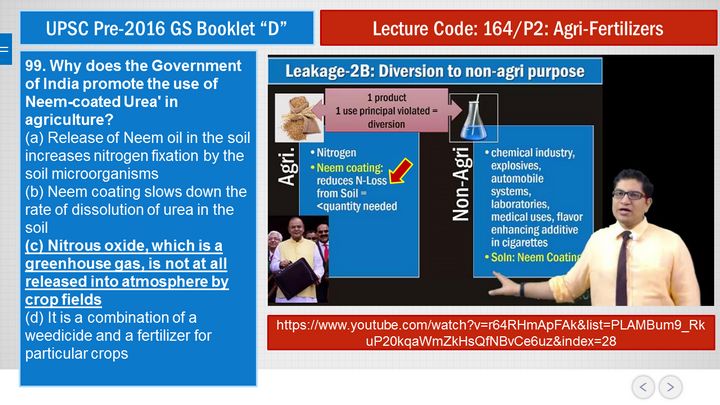
Mrunal Lecture BES164/P2: “Neem coating reduces N-loss from soil, therefore less quantity needed.- hence Government promoting” This eliminates A and D.
- C is wrong because it uses the term “not at all”. This year’s exam, all the statements containing absolute terms – are proven wrong. So, by gut feeling we are left with answer “B”. Let’s cross check- yes it’s true
- Ref:#1- Neem has properties that check nitrogen loss at each stage. It slows down the process of nitrate formation and hence excess nitrate is not available for denitrification.” says downtoearth website
- Ref:#2- Neem has proven nitrification inhibition properties. This way it slow down the process of nitrogen release from urea. Says this fertilizer company
96. With reference to ‘Pradhan Mantri Fasal Bima Yojana’, consider the following statements:
1. Under this scheme, farmers will have to pay a uniform premium of two percent for any crop they cultivate in any season of the year.
2. This scheme covers post-harvest losses arising out of cyclones and unseasonal rains.
Which of the statements given above is/are correct?
(a) 1 only
(b) 2 only
(c) Both 1 and 2
(d) Neither 1 nor 2
<atarget=”_blank” title=”Proof screenshot that UPSC prelim question could be solved from Mrunal.org – because bogus marketing propoganda is as important as teaching” href=”http://flic.kr/p/KUQx7Y”>
Mrunal’s Lecture BES164/P3: first statement is wrong. Premium varies depending on crop. And by gut-feeling too it has to be wrong because the statement contains absolute term “Any crop”.
Post-harvest loss also concluded – IE Jan 2016. So 2nd statement is right. Some people have doubt whether cyclone and unseasonal rains covered in post-harvest. Answer is yes- Ref: page-2 of Haryana government notification for this scheme. Hence, only 2nd statement correct.


![[Errors/discrepancy] 16 MCQs where UPSC Official Prelims-2020 Answerkey & Coaching classes differ, while 2 MCQs cancelled](https://mrunal.org/wp-content/uploads/2021/11/csp2020-akey-differ-table-500x383.png)
Its jaymishra721@gmail.com
Dear Friends, i have done one silly mistake while filling role number in OMR in paper 1. Though i wrote it correct in digit forms but while filling i did mistake in one digit and then corrected it by chief invigilator by whitener. Please was that ok in you knowledge or anything to do know. I am getting 115+.. negativing all doubts questions. Please
whitener ka prayog varjit hota h ….kintu score acha h …..Ishwar kripa karega
Agle saal se age criteria change hoega Kya????
my date of birth is 22-07-1985. Can i appear for upsc prelims 2017. General Category.
No
Brother..I did d same mistake in second paper….bt many seniors n my frnds r saying dat it is nt a big issue…upsc doesn’t reject candidates on these basis..yet m worried too..I think we should confirm once by contacting upsc itslef..we can mail or go there(dhaulpur house) also..
Drip irrigation no weeds grow or less growth of weeds, no loggin of water so no salinity, no water run off so no soil Eros… den ans sud be D …………I think as upsc turns every word so era s difference in less n reduction
Dont worry about it, I used whitener to correct my answer in prelim, I was through that year.
Environment & Economy k liy kons book leni chahiy??
i am new aspirent . Pls suggest how to cover the syllabus so that i may clear next year upsc exam?
It seems that upsc may reduce the age limit for gen from 32 yrs, any idea sirji? will that be implemented in 2017? please help friends………..
Mrunal Bhai……Post something about cds exam ….about current pattern ….analysis of question papers ……
Is UPSC going to reduce general age limit??
hi mrunal sir thanks for your help but i face the problem of silly mistakes in prelims can u help me with the solution to avoid such things
i am new aspirent. pls suggest mi how to start my study for next year plan?
UPSC may reduce age limit to 26 yrs. within a period of 5-7 yrs. according to INDIAN EXPRESS
I wanna question for geography optional paper 2. Can someone help me?
For Question number 58 , Kindly go through this link: http://pib.nic.in/newsite/erelcontent.aspx?relid=45399
i want upsc 2016 solved question papers
Aspirant Sir ; paper 1 143 my Paper 2 67…Am I qualifyed pre?I is sad please tel.english is bad….tell I book for mains English..1st timer
PLEASE FRIENDS HELP ME ON THIS. AND SORRY FOR POSTING IN THIS THREAD. BUT THING IMPORTANT!! HAS THERE BEEN A recommendation TO LOWER UPSC AGE?? BY KAUSHIK COMMITTEE? HRD SECRETARY?? PLS VERY IMP – ANSWER FRIENDS
don’t ever thnk abt it . it’s a psychological war for nothing … be cool n prepare well